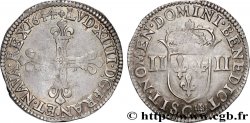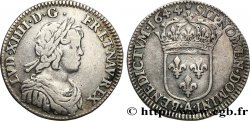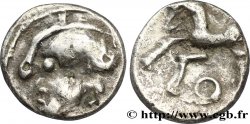fme_709571 - LOUIS XIV "THE SUN KING" Médaille, Avènement du duc d’Anjou au trône d’Espagne, refrappe
50.00 €
Quantità
Aggiungi al carrello

Tipo : Médaille, Avènement du duc d’Anjou au trône d’Espagne, refrappe
Data: (1700)
Nome della officina / città: Monnaie de Paris
Metallo : bronzo
Diametro : 40,5 mm
Asse di coniazione : 12 h.
Incisore MAUGER Jean (1648-1712)
Peso : 35,56 g.
Orlo : lisse + corne BRONZE
Marchio : corne BRONZE
Commenti sullo stato di conservazione:
Exemplaire présentant des coups et rayures, notamment dans les champs
N° nelle opere di riferimento :
Diritto
Titolatura diritto : LUDOVICUS MAGNUS REX CHRISTIANISSIMUS.
Descrittivo diritto : Buste de Louis XIV à droite, signé : J. MAVGER. F.
Traduzione diritto : Louis le Grand, roi très chrétien.
Rovescio
Titolatura rovescio : REX HISPANORUM VOTIS CONCESSUS. ; À L’EXERGUE : PHIL. DUX ANDEG. / M. DCC.
Descrittivo rovescio : Le roi debout devant son trône dans les appartements royaux. A sa droite le duc d’Anjou qui reçoit l’ambassadeur espagnol, agenouillé devant lui. Au fond des gentilshommes.
Commento
Le 1er novembre 1700 mourut à Madrid le roi d’Espagne, Charles II, “le moribond qui avait mis trente-deux ans à mourir”. Dans son testament, Charles II avait légué sa couronne et toutes les dépendances au duc d’Anjou, second petit-fils de Louis XIV. L’acceptation de ce testament par Louis XIV était un des événements les plus importants du règne et avait de graves conséquences pour la France et l’Europe, car les puissances n’étaient pas prêtes à tolérer une nouvelle vogue d’expansion française trois années après la conclusion de la paix de Ryswick.
Le 16 novembre, Louis XIV présenta le duc d’Anjou à l’ambassadeur d’Espagne et aux courtisans réunis dans le cabinet à Versailles en disant : “Messieurs, voilà le roi d’Espagne. La naissance l’appelait à cette couronne, le feu roi aussi par son testament. Toute la nation l’a souhaité et me l’a demandé instamment. C’était l’ordre du ciel, je l’ai accordé avec plaisir”. Il en résulta une nouvelle guerre qui durera jusqu’en 1713.
Jean Mauger, né en 1648, fut élève de Jean Warin. Mauger était médailliste du Roi et travaillait sous le contrôle de l'Académie des Inscriptions et Belles-Lettres. En 1698, il obtînt un appartement au Louvre. Il grava une série très importante de médailles de Louis XIV. Ces médailles historiques furent gravées entre 1697 et 1703.
On November 1, 1700, the King of Spain, Charles II, “the dying man who had taken thirty-two years to die,” died in Madrid.. In his will, Charles II bequeathed his crown and all the dependencies to the Duke of Anjou, second grandson of Louis XIV.. The acceptance of this testament by Louis XIV was one of the most important events of the reign and had serious consequences for France and Europe, because the powers were not ready to tolerate a new vogue of French expansion three years after the conclusion of the Peace of Ryswick..
On November 16, Louis XIV presented the Duke of Anjou to the Spanish ambassador and the courtiers gathered in the cabinet at Versailles, saying: “Gentlemen, here is the King of Spain. Birth called him to this crown, the late king also by his will. The whole nation wished for it and urged me to do so.. It was the order of heaven, I granted it with pleasure.”. This resulted in a new war that lasted until 1713..
Jean Mauger, born in 1648, was a student of Jean Warin. Mauger was a medallist to the King and worked under the supervision of the Academy of Inscriptions and Belles-Lettres. In 1698 he obtained an apartment in the Louvre. He engraved a very important series of medals of Louis XIV. These historic medals were engraved between 1697 and 1703
Le 16 novembre, Louis XIV présenta le duc d’Anjou à l’ambassadeur d’Espagne et aux courtisans réunis dans le cabinet à Versailles en disant : “Messieurs, voilà le roi d’Espagne. La naissance l’appelait à cette couronne, le feu roi aussi par son testament. Toute la nation l’a souhaité et me l’a demandé instamment. C’était l’ordre du ciel, je l’ai accordé avec plaisir”. Il en résulta une nouvelle guerre qui durera jusqu’en 1713.
Jean Mauger, né en 1648, fut élève de Jean Warin. Mauger était médailliste du Roi et travaillait sous le contrôle de l'Académie des Inscriptions et Belles-Lettres. En 1698, il obtînt un appartement au Louvre. Il grava une série très importante de médailles de Louis XIV. Ces médailles historiques furent gravées entre 1697 et 1703.
On November 1, 1700, the King of Spain, Charles II, “the dying man who had taken thirty-two years to die,” died in Madrid.. In his will, Charles II bequeathed his crown and all the dependencies to the Duke of Anjou, second grandson of Louis XIV.. The acceptance of this testament by Louis XIV was one of the most important events of the reign and had serious consequences for France and Europe, because the powers were not ready to tolerate a new vogue of French expansion three years after the conclusion of the Peace of Ryswick..
On November 16, Louis XIV presented the Duke of Anjou to the Spanish ambassador and the courtiers gathered in the cabinet at Versailles, saying: “Gentlemen, here is the King of Spain. Birth called him to this crown, the late king also by his will. The whole nation wished for it and urged me to do so.. It was the order of heaven, I granted it with pleasure.”. This resulted in a new war that lasted until 1713..
Jean Mauger, born in 1648, was a student of Jean Warin. Mauger was a medallist to the King and worked under the supervision of the Academy of Inscriptions and Belles-Lettres. In 1698 he obtained an apartment in the Louvre. He engraved a very important series of medals of Louis XIV. These historic medals were engraved between 1697 and 1703








 Segnalare un errore
Segnalare un errore Stampate la pagina
Stampate la pagina Condividi mia selezione
Condividi mia selezione Fai una domanda
Fai una domanda Consegnare / vendere
Consegnare / vendere
 Descrittivo
Descrittivo










